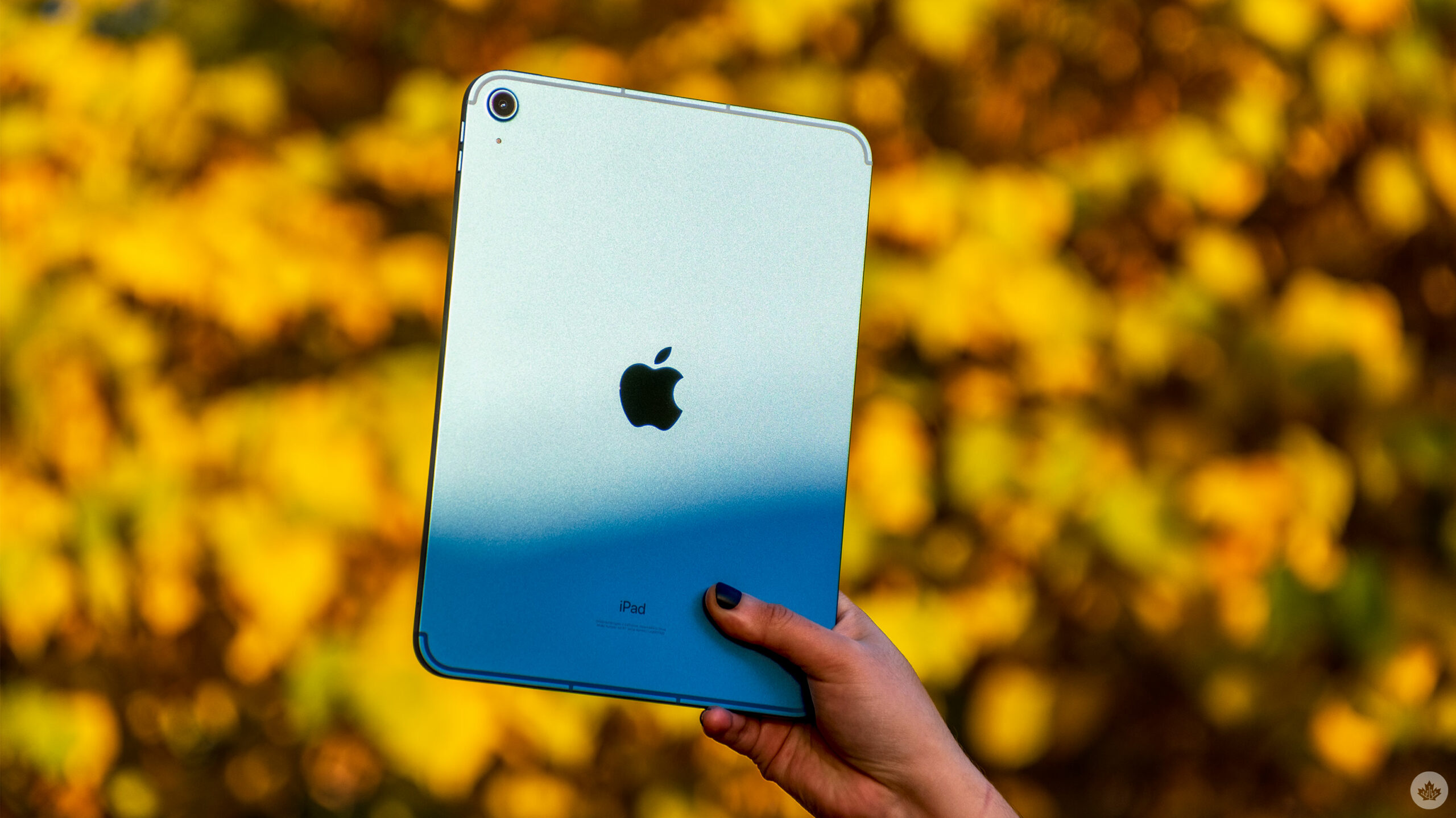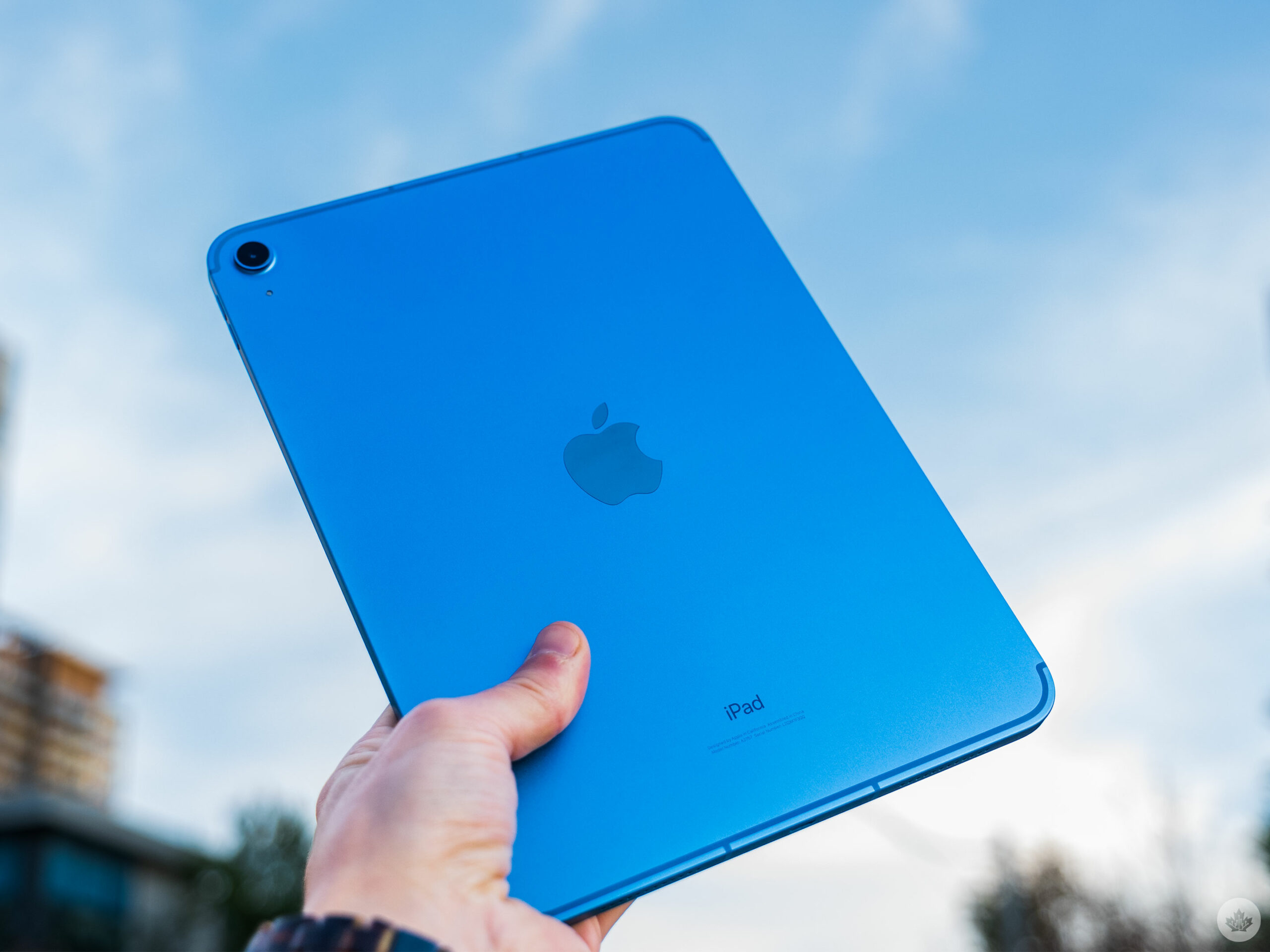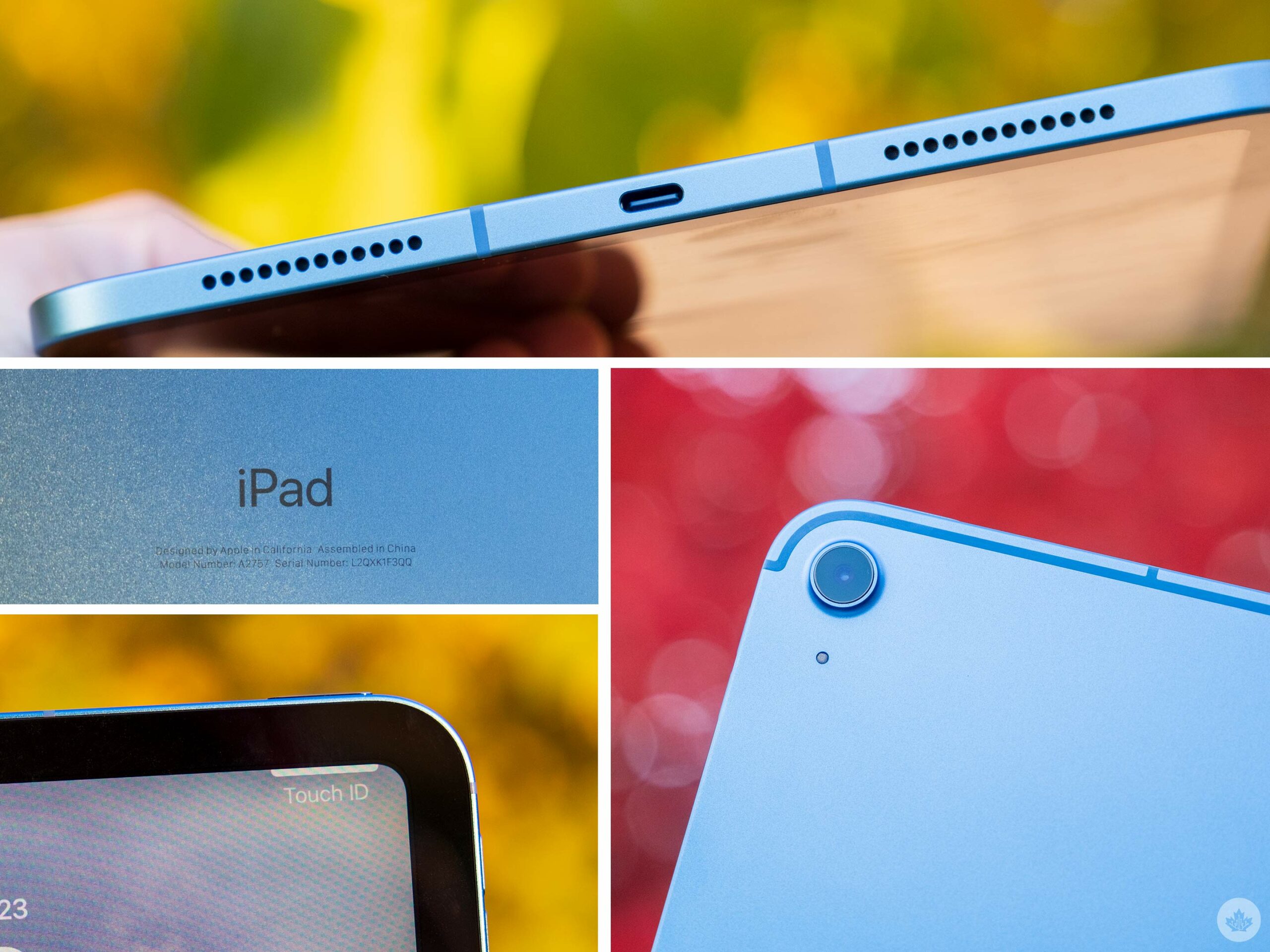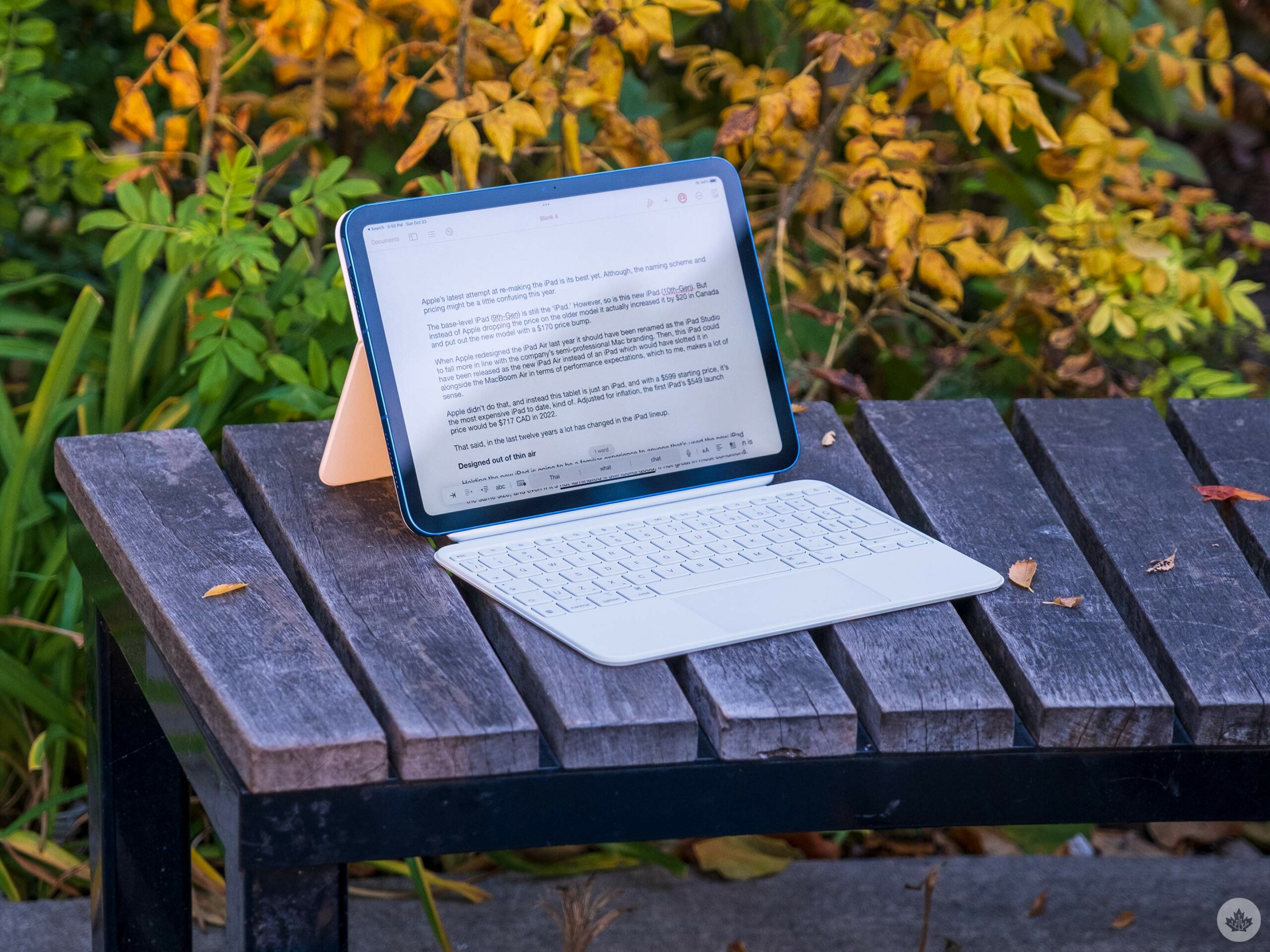
The Pros
- Great design
- Large screen
- Snappy processor
The Cons
- Expensive
- No stage manager
- Apple Pencil Gen 1?
Apple’s latest attempt at re-making the iPad is its best yet. Although, its naming scheme and pricing are a little confusing this year.
The base-level iPad (9th-Gen) is still the ‘iPad,’ but so is the new iPad (2022). Further, instead of Apple dropping the price on the older model like usual, it increased it by $20 in Canada and released the new 10th-Gen model with a substantial $170 price bump.
It seems like Apple is possibly adjusting the cost based on inflation by still keeping around the older products and raising the prices of the new tablet. While fair from a business perspective, I still think the company could have restructured its iPad offerings lineup to fit this new tablet into the lineup more slyly.
When Apple redesigned the iPad Air last year, it should have been renamed to the iPad Studio to better align with the company’s semi-professional Mac branding. Then, this iPad could have been released as the new iPad Air instead of the entry-level iPad, allowing it to slot in alongside the MacBook Air in terms of performance expectations.
Apple didn’t do that. Instead, this tablet is just an iPad with a $599 starting price, making it one of the most expensive entry-level iPads to date. Adjusted for inflation, the first iPad’s $549 launch price would be $717 in 2022. That said, iPads have become much more than just tablets in the past twelve years, so in a sense, is this price justified? Let’s find out.
Designed out of thin Air
 Holding the new iPad will be a familiar experience for anyone that has used the modern iPad Air or the 11-inch iPad Pro. The form factor of the metal shell is identical. The screen is the same 10.9-inch size, and even if it’s not laminated, it still looks good, if not great, under most conditions.
Holding the new iPad will be a familiar experience for anyone that has used the modern iPad Air or the 11-inch iPad Pro. The form factor of the metal shell is identical. The screen is the same 10.9-inch size, and even if it’s not laminated, it still looks good, if not great, under most conditions.
At 500 nits of brightness, it could be better in sunlight, but for most tasks, it’s fine. I’ll also mention that the iPad still features a 60Hz display refresh rate like the iPad before it and the iPad Air. Only Apple’s iPad Pro offers the 120Hz panel so far.
The tablet also offers a comfortable weight that feels premium but isn’t too heavy. Out of all the colours, ‘Yellow’ and ‘Pink’ stand out the most, but the ‘Blue’ variant I have is still eye-catching.
 The iPad (2022) features a similar 12-megapixel camera system to the Air’s, and the fabled USB-C port is here to take us to the future, even if it means you need to buy an adapter ($10) to work with the Apple Pencil. It would have been ideal to see Apple add support for both Pencil generations to this iPad since it has flat sides that could easily fit a magnetic Pencil dock, but unfortunately, that’s not the case. I would not be surprised if that upgrade comes around in the next model or whenever Apple finally kills the lightning port in the iPhone.
The iPad (2022) features a similar 12-megapixel camera system to the Air’s, and the fabled USB-C port is here to take us to the future, even if it means you need to buy an adapter ($10) to work with the Apple Pencil. It would have been ideal to see Apple add support for both Pencil generations to this iPad since it has flat sides that could easily fit a magnetic Pencil dock, but unfortunately, that’s not the case. I would not be surprised if that upgrade comes around in the next model or whenever Apple finally kills the lightning port in the iPhone.
Beyond the inclusion of USB-C, the other nice improvement is the iPad’s front-facing camera has finally been moved to the long edge of the iPad, making video calls feel more natural with the iPad horizontal. This camera is 12 megapixels and looks fine, but it’s not spectacular. ‘Center Stage’ is useful too, but being unable to fully punch out to the full ultra-wide camera during a FaceTime call feels like a miss.
 The rear camera is a significant upgrade and people (like your grandma) that take photos with the tablet will notice a welcome increase in clarity and sharpness over the older 8-megapixel sensor in the 9th-Gen iPad. But again, the improvement isn’t substantial, and the camera isn’t nearly as good as any modern iPhone I’ve tested from the iPhone 11 onwards.
The rear camera is a significant upgrade and people (like your grandma) that take photos with the tablet will notice a welcome increase in clarity and sharpness over the older 8-megapixel sensor in the 9th-Gen iPad. But again, the improvement isn’t substantial, and the camera isn’t nearly as good as any modern iPhone I’ve tested from the iPhone 11 onwards.
One excellent upgrade is in the speakers. They easily fill a small room, and as I wrote this review with the iPad’s on-screen keyboard while jamming out to the new Arctic Monkeys album, I enjoyed how great they sound. The speakers sound substantially more full at max volume than the 9th-Gen iPad and the iPad mini. Plus, they feature ample stereo separation when you’re using the tablet in front of you. It’s nice, but does it compensate for the headphone jack’s removal? It’s hard to tell in a world where everyone seems to have wireless earbuds.
I’ll mention that the three random USB-C-to-AUX adapters I have that are designed for Android phones didn’t work with the iPad (or any of Apple’s tablets), so you’ll likely need to buy one from Apple if you want to go down this route. USB-C earbuds, on the other hand, do work.
 Alongside the new screen size, Apple also brought over the Touch ID sensor from the iPad Air that’s embedded in the power button. It works well here but is not as seamless as Face ID or Touch ID on the home button. It’s a minor gripe, but I often open the iPad expecting it to unlock before I remember to rest my finger on the power button to sign in.
Alongside the new screen size, Apple also brought over the Touch ID sensor from the iPad Air that’s embedded in the power button. It works well here but is not as seamless as Face ID or Touch ID on the home button. It’s a minor gripe, but I often open the iPad expecting it to unlock before I remember to rest my finger on the power button to sign in.
Overall it’s an expertly designed iPad with a great screen, and the bump up in size makes typing on the display or with a keyboard case a little less cramped. There’s no denying it’s an improvement over the 9th generation iPad, and in terms of build quality, it’s close to offering the same excellent quality as the new iPad Air.
Specs
iPad (2022)
iPad (2021)
iPad Air (2022)
Display
10.9-inch IPS Liquid Retina display, 1640 x 2360 pixel resolution
10.2-inch IPS Retina LCD display, 2160 x 1620 pixel resolution
10.9-inch IPS Liquid Retina display, 2360 x 1640 pixel resolution
Processor
A14
Apple A13 Bionic
M1 chip
RAM
Storage
64GB, 256GB
32GB, 128GB
64GB, 256GB
Dimensions (in.)
248.6 x 179.5 x 7mm
250.6 x 174.1x 7.5mm
247.6 x 178.5 x 6.1mm
Weight
477g
490g
458g
Rear Facing Camera
12-megapixel (f/1.8 wide)
1.2-megapixel (f/2.4 aperture)
1.2-megapixel (f/1.8 aperture)
Front Facing Camera
12-megapixel (f/2.4, ultrawide)
7-megapixel (f/2.2 aperture)
12-megapixel (ultrawide)
OS
iPadOS 16
iPadOS 16
iPadOS 15
Battery
Network Connectivity
LTE/5G
Wi-Fi up to 802.11.ac, LTE (23 bands), Bluetooth 5.0, GSM / CDMA / HSPA / EVDO / LTE
LTE/ 5G
Sensors
Fingerprint (top-mounted), accelerometer, gyro, compass, barometer
Touch ID, Three axis gyro, Accelerometer, Ambient light sensor, Barometer
Touch ID, Three axis gyro, Accelerometer, Ambient light sensor, Barometer
SIM Type
Nano SIM, eSIM
Nano SIM, eSIM
Launch Date
March 18, 2022
Misc
Colours: Silver, Blue, Pink, Yellow
Silver, Space Gray
Colours: Space Grey, Starlight, Pink, Purple, Blue
Display
iPad (2022)
10.9-inch IPS Liquid Retina display, 1640 x 2360 pixel resolution
iPad (2021)
10.2-inch IPS Retina LCD display, 2160 x 1620 pixel resolution
iPad Air (2022)
10.9-inch IPS Liquid Retina display, 2360 x 1640 pixel resolution
Processor
iPad (2022)
A14
iPad (2021)
Apple A13 Bionic
iPad Air (2022)
M1 chip
RAM
iPad (2022)
iPad (2021)
iPad Air (2022)
Storage
iPad (2022)
64GB, 256GB
iPad (2021)
32GB, 128GB
iPad Air (2022)
64GB, 256GB
Dimensions (in.)
iPad (2022)
248.6 x 179.5 x 7mm
iPad (2021)
250.6 x 174.1x 7.5mm
iPad Air (2022)
247.6 x 178.5 x 6.1mm
Weight
iPad (2022)
477g
iPad (2021)
490g
iPad Air (2022)
458g
Rear Facing Camera
iPad (2022)
12-megapixel (f/1.8 wide)
iPad (2021)
1.2-megapixel (f/2.4 aperture)
iPad Air (2022)
1.2-megapixel (f/1.8 aperture)
Front Facing Camera
iPad (2022)
12-megapixel (f/2.4, ultrawide)
iPad (2021)
7-megapixel (f/2.2 aperture)
iPad Air (2022)
12-megapixel (ultrawide)
OS
iPad (2022)
iPadOS 16
iPad (2021)
iPadOS 16
iPad Air (2022)
iPadOS 15
Battery
iPad (2022)
iPad (2021)
iPad Air (2022)
Network Connectivity
iPad (2022)
LTE/5G
iPad (2021)
Wi-Fi up to 802.11.ac, LTE (23 bands), Bluetooth 5.0, GSM / CDMA / HSPA / EVDO / LTE
iPad Air (2022)
LTE/ 5G
Sensors
iPad (2022)
Fingerprint (top-mounted), accelerometer, gyro, compass, barometer
iPad (2021)
Touch ID, Three axis gyro, Accelerometer, Ambient light sensor, Barometer
iPad Air (2022)
Touch ID, Three axis gyro, Accelerometer, Ambient light sensor, Barometer
SIM Type
iPad (2022)
iPad (2021)
Nano SIM, eSIM
iPad Air (2022)
Nano SIM, eSIM
Launch Date
iPad (2022)
iPad (2021)
iPad Air (2022)
March 18, 2022
Misc
iPad (2022)
Colours: Silver, Blue, Pink, Yellow
iPad (2021)
Silver, Space Gray
iPad Air (2022)
Colours: Space Grey, Starlight, Pink, Purple, Blue
Inside the iPad, Apple added the A14 Bionic chip from the iPhone 12 series. This 64-bit six-core chip should be more than capable of the modern iPad workload.
Compared to the 4th Generation iPad Pro with the A12Z, I’m finding its performance more than comparable. Nevertheless, stacked up against Apple’s modern iPad suite, it falls into place a little behind the iPad mini, but it’s a decent jump over the last three generations of iPad at least.
This slideshow requires JavaScript.
I didn’t try to edit video with the iPad since all I expect from it is solid playback and the ability to cut up short clips shot on the iPad or the iPhone. Still, for gaming, the tablet held up well and had me cruising through matches of Apex Legends and into the mines of RogueJack. It’s not playing Divinity 2 with console-level graphics like the M-series of iPads, but for 98 percent of apps, it gets the job done efficiently.
An iPad or a computer?
 Alongside the new iPad, Apple also released a new Magic Keyboard Folio ($329) that turns this iPad into more of a computer like the existing Magic Keyboards ($399-$449) for the iPad Air and Pro lineup.
Alongside the new iPad, Apple also released a new Magic Keyboard Folio ($329) that turns this iPad into more of a computer like the existing Magic Keyboards ($399-$449) for the iPad Air and Pro lineup.
The key travel is just as clicky on the new keyboard as the other Magic Keyboards, but it doesn’t fold up as elegantly. Instead, it’s two pieces, with the back being a kickstand that you can use with or without the keyboard half. This is useful and, unlike the standard Magic Keyboard, works well for media consumption and heavier typing. The new Folio version is arguably better, with a larger trackpad and an entire row of function keys, but at the end of the day, both are quite similar.
I wrote 90 percent of this review with the Smart Folio case (not the keyboard) and typing on the iPad’s screen. To me, there’s still something to be said about how much you can do with an iPad without any accessories, but I know that most people seem to like the keyboard attachments, so to each their own, but I think for light work, it’s not necessary.
“There’s still something to be said about how much you can do with an iPad without any accessories”
I will say that when using the keyboard\mouse, I found it easier to type and work in Apple’s apps like Pages instead of Google Docs since Google’s apps aren’t updated to work with the adaptive cursor when you’re using a mouse with an iPad.
This iPad also doesn’t get Apple’s fancy new ‘Stage Manager’ software that allows you to run concurrent windows on iPad, so you’re forced to multitask the old way. I’ve been testing Stage Manager on the M2-powered 12.9-inch iPad Pro, and it makes using the Magic Keyboard more intuitive.
Apple recently announced that Stage Manager will come to the iPad Pro (2018), which scores very similarly to this iPad when benchmarked. This suggests it’s not a lack of power holding Stage Manager back from the new iPad. It’s worth noting that only M-series chip iPads include the option to use Stage Manager with a secondary display.
Who's buying what?
There's something to be said about the plethora of choices in the iPad lineup. Anywhere from $449 to $1500 will get you a great tablet from Apple. However, the discrepancy between those two cost extremes is clear.
The differences between the 9th generation iPad, the new iPad and the iPad Air, which are separated by $200, require more specifics. To make things even more confusing, all of the base prices start with 64GB of storage and can be upgraded to 256GB for what is roughly the price of the base model of the next step up in the lineup.
The Air is the easiest to separate since it works with the Apple Pencil (2nd-Gen) and features the most power, making it the most future-proof of all the iPads and likely the most functional for creatives. Especially digital artists, illustrators, or people looking to take advantage of Stage Manager and a keyboard/mouse setup.
Of the two remaining full-sized iPads in the sub $1,000 bracket, the new iPad is the one I prefer the most since it has a new design, but if you plan to browse the web and watch YouTube, there's not a lot that it offers over the existing model.
There is a powerful push to make the new iPad more computer-like with the Magic Keyboard Folio, but I'm still not sure if that's the right market for this device. The new iPad can hit up to $928 with the keyboard, substantially more than the entry-level iPad/keyboard combo that comes in at $648. There's no denying there's a jump-up in quality. Still, the market was looking for a new entry-level iPad and not a slightly less expensive iPad Air that can't run Stage Manager, despite being about as powerful as the second-generation iPad Pro that released in 2018 (which, as a side note, is no small feat).
That's not even mentioning how close in price this iPad is to the M1 MacBook Air, which is an outstanding machine.
All this creates a confusing iPad generation. With this in mind, if you're tight on cash, the Gen-9 iPad will be fine. If you want to treat yourself a little, Apple’s new iPad is pretty slick, and if you want a top-end iPad experience, the new Air with the Apple Pencil Gen 2 is an amazing tablet.
Good luck out there. Apple’s 10th-Gen iPad (2022) releases on October 26th starting at $599.
MobileSyrup utilizes affiliate partnerships. These partnerships do not influence our editorial content, though we may earn a commission on purchases made via these links that helps fund the journalism provided free on our website.
"All this creates a confusing iPad generation. With this in mind, if you're tight on cash, the Gen-9 iPad will be fine. If you want to treat yourself a little, Apple’s new iPad is pretty slick"
MobileSyrup may earn a commission from purchases made via our links, which helps fund the journalism we provide free on our website. These links do not influence our editorial content. Support us here.















